National Theatre, Boston (1836)
The National Theatre (1836-1863) was a theatre in the West End of Boston, Massachusetts, in the mid-19th century.[1][2] William Pelby established the enterprise in 1836, and presented productions of "original pieces, and the efforts of a well selected stock company, which, with few exceptions, have been American. The scenery is of the highest order, and the business of the stage well directed. Mr C.A. Eaton made his debut at this theatre, and here Mr. F.S. Hill's early labors were eminently successful. Mr. J.S. Jones has written and produced on this stage thirty pieces, embracing every department except tragedy."[3] William Washburn designed the building, erected on the site of the former Warren Theatre. Performers at the National included Edwin Adams, Marietta Zanfretta, Jean Margaret Davenport,[4] Julia Dean, Jonathan Harrington, W.H. Smith,[5] Mary Ann Vincent, and Billy Whitlock. In 1852 the theatre burnt down, and was rebuilt.[6] In 1863 the building was again destroyed by fire.[7]
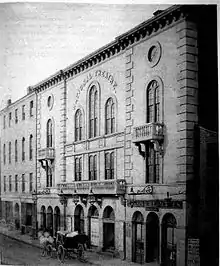
Architecture
In 1836:
"this theatre, planned and erected by Mr William Washburn, is 120 by 76 feet (23 m), exclusive of the saloons, refreshment rooms, &c., which are contained in an adjoining building, 20 by 60 feet (18 m), fronting on Traverse Street, and communicating with the lobbies. The leading architectural features are Doric presenting brood pilasters with slight projections on the front which support an.unbroken entablature and a pediment, 18 feet (5.5 m) high at each end. The roof is covered with slate and zinc, and is surmounted by an octagonal lantern, 12 feet (3.7 m) in diameter and 18 feet (5.5 m) high, having a window on each of its sides. The structure is covered on the exterior walls with cement, in imitation' of granite, which gives a uniform and beautiful appearance. The interior comprises a pit, with 600 seats, three tiers of boxes, with 336 seats each, and a gallery with 200 seats. The saloons, lobbies, refreshment rooms, &c. are spacious, convenient and well ventilated by large windows on the two streets and in rear. The boxes have five rows of seats each, and are accessible from both streets, affording, in case of fire or other cause of alarm, ready egress from the house. The main roof is supported by 18 hard pine pillars, 36 feet (11 m) high and 10 inches square, which also support a portion of the boxes, and divide them from the lobbies. The remaining boxes are supported by 2 octagonal pillars of the same material, 9 inches in diameter. The main ceiling is a single arch, of 55 feet (17 m) span, rising within 9 feet (2.7 m) of the ridge. The gallery is entirely above the level cornice of the building, having an arched ceiling which rises five feet higher than the main ceiling, and is ventilated by a large round window placed in the centre of the tympanum. The proscenium presents an opening 40 feet (12 m) wide and 33 feet (10 m) high. It is composed of pilasters, having ornamented capitals and bases, which support a beautifully enriched arch, crowned with the American eagle. The depth of the stage is 61 feet (19 m). The circle of boxes is so arranged, that in every part of the house a full view is had of the stage. The decorations are in good taste. The lower tier of boxes is adorned with paintings of the battles of the United States Navy; the second tier bears the arms of the States, and the upper parts have appropriate scenes from the Iliads."[3]
Performances
| Year | Play | Author |
|---|---|---|
| 1837 | Carpenter of Rouen! or The confrerie of St. Bartholomew | J.S. Jones[8] |
| 1838 | 3 degrees of Banking | J.S. Jones[8] |
| 1838 | Surgeon of Paris; or, The Mask of the Huguenots | Joseph Stevens Jones |
| 1838 | Hamlet[9] | |
| 1838 | Valet de Sham | Charles Selby[8] |
| 1839 | ||
| 1839 | Moll Pitcher; or, The Fortune Teller of Lynn | |
| 1839 | Solon Shingle; or, The People's Lawyer | Joseph Stevens Jones |
| 1842 | Ivanhoe[10] | |
| 1844 | Jack Sheppard | J.B. Buckstone[8] |
| 1844 | Nervous Man | William Bayle Bernard[8] |
| 1846 | Wizard of the wave! or—The ship of the avenger! | John Thomas Haines[8] |
| 1848 | ||
| 1848 | Jonathan Harrington (ventriloquist)[11] | |
| 1849 | Serpent of the Nile[8] | |
| 1849 | Ben the Boatswain | Thomas Egerton Wilks[12] |
| 1849 | Mazeppa or The wild horse of Tartary[8] | |
| 1849 | Ivanhoe! or—The knights templars[8] | |
| 1851 | Stranger or,--Misanthropy & repentance | Kotzebue[8] |
| 1851 | Honey moon or, how to rule a wife | John Tobin[8] |
| 1852 | Philip Augustus of France | J. Westland Marston[13] |
| 1852 | I've Swallowed a Policeman[8] | |
| 1852 | Heir-at-Law | |
| 1853 | Pet of the petticoats | John Baldwin Buckstone[8] |
| 1853 | Fortunio and his seven gifted servants | Madame d'Aulnoy/James Planché[8] |
| 1853 | Madelaine, The Belle of the Faubourg | Virginia Cunningham[14][15] |
| 1853 | Faint heart never won fair lady | J.R. Planche[8] |
| 1853 | Wept of the Wish-ton-Wish | Wm. Bayle Bernard[8] |
| 1853 | Tower of Nesle! or The chamber of death | George Almar, adapted from Dumas and Gaillardet's La tour de Nesle.[8] |
| 1853 | Six degrees of crime | Frederic Stanhope Hill[8][16][17] |
| 1853 | Gale Breezely! or, The tale of a tar | J.B. Johnstone[8][18] |
| 1853 | Ernest Maltravers: or, The robber father and maniac daughter | Bulwer-Lytton[8] |
| 1853 | Lady of Lyons | Bulwer[8] |
| 1854 | Egyptian Prince, "the very popular Ethiopian farce"[8] | |
| 1854 | Othello[8] | |
| 1854 | That Good for Nothing[8] | |
| 1854 | Faustus[8] | |
| 1854 | Monte Cristo[8] | |
| 1854 | Sledge Driver | Planche[8] |
| 1854 | Much Ado About Nothing[8] | |
| 1854 | Mary Tudor or, The artisan and the Jew[8] | |
| 1854 | Fallen angel or Faust and Margaret | Dion Boucicault[8] |
| 1854 | Devil's in it[8] | |
| 1854 | Invisible prince! or, The island of tranquil delights | Planche[8] |
| 1856 | Cushing's New York Circus[19] | |
| 1858 | Three fast men Or, The female Robinson Crusoes[8] | |
| 1858 | Linda, the Cigar Girl[8] | |
| 1858 | O'Flanagan and the fairies[8] | |
| 1858 | Buck bison: or, Baby Blanche, the child of the prairie[8] | |
| 1858 | Woman's love Or, The secrets of the heart[8] | |
| 1858 | Farmer's son Or, The golden axe[8] | |
| 1859 | Inez, the poisoner | Frederic S. Hill[8] |
| 1859 | Flowers of the Forest, A gipsey story | J.B. Buckstone[8] |
| 1859 | Cross of gold, or Theresa's vow[8] | |
| 1859 | Three guardsmen or, The seige [sic?] of Rochelle[8] | |
| 1859 | Magic pills! Or, The conjuror's gift, "a grand Christmas pantomime"[8] |
Images
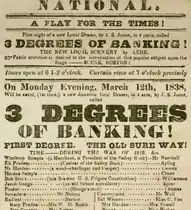 Advertisement for "3 Degrees of Banking," 1838
Advertisement for "3 Degrees of Banking," 1838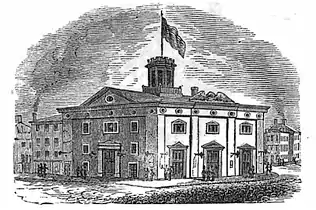 The National, designed by William Washburn, as it appeared ca.1838
The National, designed by William Washburn, as it appeared ca.1838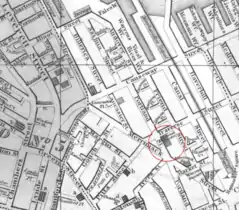 Detail of 1846 map of Boston, showing National Theatre at corner of Portland St. and Traverse St.
Detail of 1846 map of Boston, showing National Theatre at corner of Portland St. and Traverse St.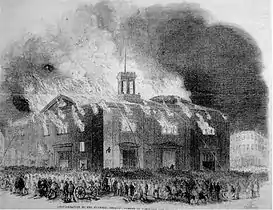 The National on fire, 1852[20]
The National on fire, 1852[20] Advertisement for "Much Ado About Nothing," 1854
Advertisement for "Much Ado About Nothing," 1854 Cushing's New York Circus, 1856
Cushing's New York Circus, 1856
Managers/Proprietors
Managers and proprietors included: William Pelby (1836-1850),[21] William B. English (ca.1857-1863), Thomas Barry, Rosalie Pelby, John B. Wright, Henry W. Fenno,[22] George Bird, Joseph Leonard, W.M. Fleming, Joseph Cushing, G.H. Griffiths, James Pilgrim, Henry Willard, Charles R. Thome, Sr., John Moran, Walter Gay, Henry Willard, F.B. Conway, E.B. Williams, Thomas Hampton, J. C. Myers, C.J. Boniface.[23]
Variant names
- Willard's National Theatre, 1856
- People's National Theatre, 1856, 1859
- Union Concert Hall, 1862
References
| Wikimedia Commons has media related to National Theatre, Boston. |
- Boston Almanac. 1841.
- Boston Directory. 1862.
- Abel Bowen (1838), Bowen's Picture of Boston (3rd ed.), Boston: Otis, Broaders and Company
- Samuel Adams Drake (1873), Old landmarks and historic personages of Boston, Boston: James R. Osgood and Co., OCLC 3012180, OL 6905745M
- John W. Frick (2003), Theatre, culture and temperance reform in nineteenth-century America, Cambridge, U.K: Cambridge University Press, ISBN 0521817781
- On April 22, 1852, the National was "entirely destroyed by fire." cf. Boston Almanac. 1853.
- The National burned down on March 24, 1863. Its remaining "stage fixtures, to a considerable extent, had been removed to the new Tremont Theatre upon the opening of that house in the early part of 1863." cf. Winsor. 1886
- American Broadsides and Ephemera, Series 1
- American Broadsides and Ephemera, Series 1, no. 5347. Title: "National. Hamlet! Mr. Pelby as Hamlet. ... On Friday evening, September 7, 1838, will be acted Shakspeare's [sic] celebrated tragedy in 5 acts, called Hamlet Prince of Denmark! ... To conclude with, the new comedietta, by Charles Selby, Esq, called The valet de Sham." 1838
- American Broadsides and Ephemera, Series 1, no. 14230. Title:" National Theatre. Stage manager Mr. Murdoch ... On Tuesday evening, April 12th. 1842. Will be performed ... the drama, in three acts, founded upon incidents in Sir Walter Scott's novel of Ivanhoe--entitled Ivanhoe! or--The Knight Templars. ... To conclude with the grand spectacle, in three parts, entitled The Naiad queen!" 1842
- Boston Daily Atlas, May 26, 1848
- Wilks. Ben the Boatswain. French's Standard Drama no.149
- American Broadsides and Ephemera, Series 1, no. 8202. Title: "March 3d, 1852, will be performed, (first time in America,) a new tragedy in 5 acts, written by J. Westland Marston, Esq. ... entitled Philip Augustus of France! ... To conclude with the new and successful farce, I've swallowed a policeman" 1852
- Cunnigham. Madelaine, The Belle of the Faubourg. NY: Samuel French, ca.1855
- WorldCat. Virginia Juhan Cunningham
- WorldCat. F.S. Hill (1805-1852)
- Frederic Stanhope Hill. The six degrees of crime, or, Wine, women, gambling, theft, murder and the scaffold: a melo drama in six parts. Boston: W.V. Spencer, 1856
- WorldCat. Johnstone, J. B. (John Beer) 1803-1891
- Ballou's Pictorial, 1856
- "Burning of the National Theatre". Gleason's Pictorial. Boston, Mass. 2. 1852.
- Richard Butsch (2000), The making of American audiences: From Stage to Television, 1750-1990, Cambridge: Cambridge University Press, ISBN 0521662532
- Henry W. Fenno died in 1862; cf. Daily Picayune (New Orleans); Date: 08-14-1862
- Justin Winsor, ed. (1880–1881), "Warren Theatre", Memorial History of Boston, 4, Boston: James R. Osgood and Company, hdl:2027/uc2.ark:/13960/t1bk1nn56, OCLC 4953409